The Classic Star Trek Phasers
Part two.. The 2nd Season - Page Two
By Richard A. Coyle
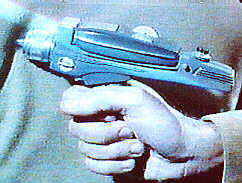 As
with the black and white models almost all of the rest of the detailing
changed from phaser to phaser.
As
with the black and white models almost all of the rest of the detailing
changed from phaser to phaser.
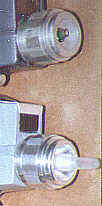 And again the second semi-constant parts I have seen have been the muzzle and
the knob-like thing on the side of the main body. Even then, I have counted
three distinct models for both the muzzle and the knob.
And again the second semi-constant parts I have seen have been the muzzle and
the knob-like thing on the side of the main body. Even then, I have counted
three distinct models for both the muzzle and the knob.
Let us study this model from "head to toe," starting at what
some would call the "business end," at the front of the phaser, right
at the tip of the emitter. These remained the same, just carried over to the
new model. The best of these tips appear to be machined acrylic, cut into a
cone shape and tapering to a blunt end with the crudest of these being simply
a piece of plastic tubing.
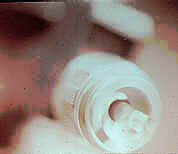 A few of the working models were hollow or drilled out and with a taper cut.
These had a grain-o'-wheat light bulb installed for a lighting effect. These
lights were believed to have been installed to aid the special effects artist
who would then key in on these lights when they drew the animated beam of a
phaser firing.
A few of the working models were hollow or drilled out and with a taper cut.
These had a grain-o'-wheat light bulb installed for a lighting effect. These
lights were believed to have been installed to aid the special effects artist
who would then key in on these lights when they drew the animated beam of a
phaser firing.
Current custom is to leave all lights out of props. The phaser in "Star
Trek - The Search For Spock" had no tip light. After all, animation is charged by the
frame and an actor firing for three seconds is cheaper than a ten second blast and he
might be aiming it wrong when he does fire.
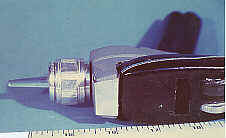
Next, is the machined aluminum muzzle, again this carried over to this new model
too. So, traveling back along the tapering tip, we come to a flat section at
right angles to the tip. This is a recessed cut into the face of the muzzle
about 1/8" deep and it is 3/4" flat wide section with the clear tip
bored right into the center.
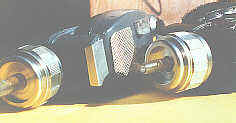
Swinging around up from this recess, we then find there are several levels of
rings that look like steps. 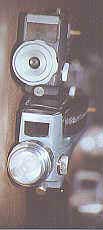 The
center one is the largest and widest ring or step of seven steps. This center
ring has sections that are divided by a mix of flat plane sections and those
that have about six to seven fine lines cut into them. It runs a flat section,
then a section with lines followed by a flat section, alternating these areas
all round this part of the barrel.
The
center one is the largest and widest ring or step of seven steps. This center
ring has sections that are divided by a mix of flat plane sections and those
that have about six to seven fine lines cut into them. It runs a flat section,
then a section with lines followed by a flat section, alternating these areas
all round this part of the barrel.









